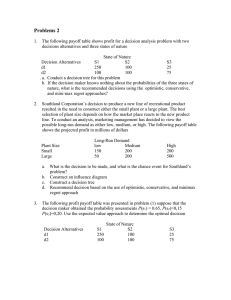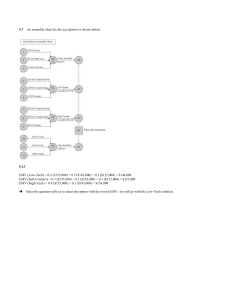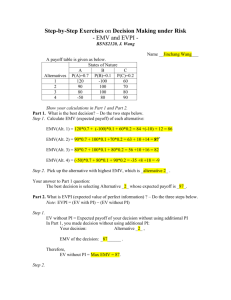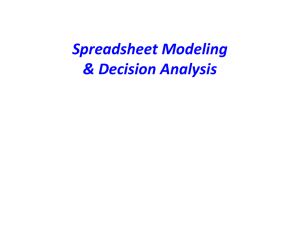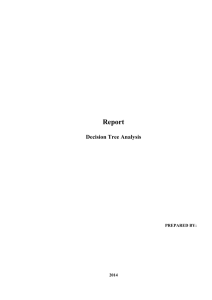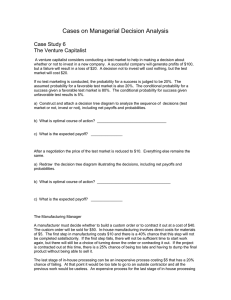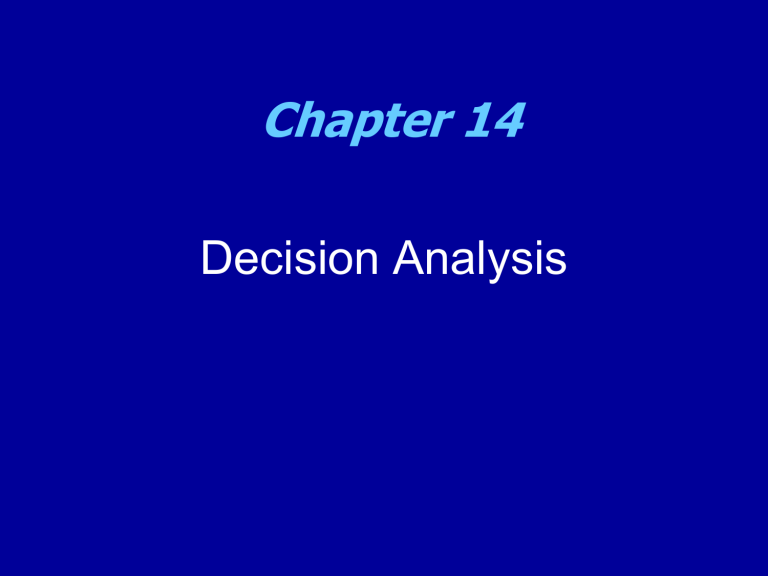
Chapter 14 Decision Analysis Introduction to Decision Analysis ▪ Modeling techniques can help managers gain insight and understanding about the decision problems they face. But models do not make decisions—people do. ▪ Decision making often remains a difficult task due to: – Uncertainty regarding the future – Conflicting values or objectives ▪ Consider the following example... Deciding Between Job Offers ▪ Company A – In a new industry that could boom or bust. – Low starting salary, but could increase rapidly. – Located near friends, family and favorite sports team. ▪ Company B – Established firm with financial strength and commitment to employees. – Higher starting salary but slower advancement opportunity. – Distant location, offering few cultural or sporting activities. ▪ How can you assess the trade-offs between starting salary, location, job security, and potential for advancement in order to make a good decision? Which job would you take? Good Decisions vs. Good Outcomes ▪ A structured approach to decision making can help us make good decisions, but can’t guarantee good outcomes. ▪ Good decisions sometimes result in bad outcomes. ▪ For example, you decide to accept the position with company B. After working for this company for 9 months, it suddenly announces that, in an effort to cut costs, it is closing the office in which you work and eliminating your job. ▪ Did you make a bad decision? Probably not. Unforeseeable circumstances beyond your control caused you to experience a bad outcome. A good decision is one that is in harmony with what you know, what you want, what you can do, and to which you are committed. ▪ This chapter describes a # of techniques that can help structure & analyze difficult decision problems in a logical manner. Characteristics of Decision Problems ▪ Alternatives - different courses of action intended to solve a problem. – Work for company A – Work for company B – Reject both offers and keep looking ▪ Criteria - factors that are important to the decision maker and influenced by the alternatives. – Salary – Career potential – Location ▪ States of Nature - future events not under the decision makers control. – Company A grows – Company A goes bust – etc. An Example: Magnolia Inns ▪ Hartsfield International Airport in Atlanta, Georgia, is one of the busiest airports in the world. ▪ It has expanded many times to handle increasing air traffic. ▪ Commercial development around the airport prevents it from building more runways to handle future air traffic. ▪ Plans are being made to build another airport outside the city limits. ▪ Two possible locations for the new airport have been identified, but a final decision will not be made for a year. ▪ The Magnolia Inns hotel chain intends to build a new facility near the new airport once its site is determined. ▪ Land values around both possible sites for the new airport are increasing as investors speculate that property values will increase greatly in the vicinity of the new airport. The Decision Alternatives 1) Buy the parcel of land at location A. 2) Buy the parcel of land at location B. 3) Buy both parcels. 4) Buy nothing. The Possible States of Nature 1) The new airport is built at location A. 2) The new airport is built at location B. Constructing a Payoff Matrix Calculating the Payoff Values • If the company buys the parcel of land near location A, and the airport is built in this area, Magnolia Inns can expect to receive a payoff of $13 million. This figure of $13 million is computed from the data shown: Present value of future cash flows if hotel & airport are built at location A $31,000,000 Current purchase price of hotel site at location A $18,000,000 $13,000,000 MINUS • If the parcels at both locations A and B are purchased then a payoff of $5M will result (if both parcels are purchased) and the airport is built at location A. This payoff value is computed as: Present value of future cash flows if hotel and airport are built at location A $31,000,000 Present value of future sales price for the unused parcel at location B +$ 4,000,000 PLUS MINUS Current purchase price of hotel site at location A -$18,000,000 Current purchase price of hotel site at location B -$12,000,000 $ 5,000,000 MINUS Constructing a Payoff Matrix Decision Rules ▪ If the future state of nature (airport location) were known, it would be easy to make a decision. – For example, if she knew the airport was going to be built at location A, a maximum payoff of $13 million could be obtained by purchasing the parcel of land at that location. Similarly, if she knew the airport was going to be built at location B, Magnolia Inns could achieve the maximum payoff of $11 million by purchasing the parcel at that location. ▪ Failing to know where the Airport will be built, a variety of “nonprobabilistic” decision rules can be applied to this problem: – Maximax – Maximin – Minimax regret ▪ No decision rule works best in all situations and each has its own weaknesses. The Maximax Decision Rule ▪ Identify the maximum payoff for each alternative. ▪ Choose the alternative with the largest maximum payoff. The MaxiMax Decision Rule ▪ Thus, if the company optimistically believes that nature will always be “on its side” regardless of the decision it makes, the company should buy the parcel at location A because it leads to the largest possible payoff. ▪ The actual payoff depends on where the airport is ultimately located. If we follow the maximax decision rule and the airport is built at location A, the company would receive $13 million; but if the airport is built at location B, the company would lose $12 million. ▪ In some situations, the maximax decision rule leads to poor decisions. ▪ Weakness: – Consider the following payoff matrix Decision A B • State of Nature 1 2 30 -10000 29 29 MAX 30 <--maximum 29 Many decision makers would prefer alternative B because its guaranteed payoff is only slightly less than the maximum possible payoff, and it avoids the potential large loss involved with alternative A if the second state of nature occurs. The Maximin Decision Rule ▪ Identify the minimum payoff for each alternative. ▪ Choose the alternative with the largest minimum payoff. The MaxiMin Decision Rule ▪ ▪ ▪ ▪ ▪ If the company pessimistically assumes that nature will always be “against us” regardless of the decision we make, then the company should buy none of the parcels because it leads to the largest minimum payoff (MaxiMin). To apply the maximin decision rule, we first determine the minimum possible payoff for each alternative and then select the alternative with the largest minimum payoff (or the maximum of the minimum payoffs—hence the term “maximin”). The largest (maximum) value in column D is the payoff of $0 associated with not buying any land. Thus, the maximin decision rule suggests that Magnolia Inns should not buy either parcel because, in the worst case, the other alternatives result in losses whereas this alternative does not. In some situations, the MaxiMin decision rule leads to poor decisions. Weakness: – Consider the following payoff matrix State of Nature Decision A B • 1 1000 29 2 28 29 MIN 28 29 <--MaxiMin In this problem, alternative B would be selected using the maximin decision rule. However, many decision makers would prefer alternative A because its worst-case payoff is only slightly less than that of alternative B, and it provides the potential for a much larger payoff if the first state of nature occurs. The Minimax Regret Decision Rule ▪ Another way of approaching decision problems involves the concept of regret, or opportunity loss. ▪ To use the minimax regret decision rule, we must first convert our payoff matrix into a regret matrix that summarizes the possible opportunity losses that could result from each decision alternative under each state of nature. ▪ For example, if the company buys the parcel at location A and the airport is built at location B, the company would experience a regret, or opportunity loss, of $23 million. ▪ Each entry in the regret matrix shows the difference between the “maximum payoff that can occur under a given state of nature” and the “payoff that would be realized from each alternative under the same state of nature”. ▪ Identify the maximum possible regret for each alternative. ▪ Choose the alternative with the smallest maximum regret. The Minimax Regret Decision Rule ▪ The entries in the regret matrix are generated from the payoff matrix as: – Formula for cell E6 =MAX(Payoffs!E$6:E$9) - Payoffs!E6 (Copy to E6 through F9) and then copied to E6:F9 – Compute the maximum regret that could be experienced with each decision alternative under each state of nature, then choose minimum regret decision. Anomalies with the Minimax Regret Rule ▪ Consider the following payoff matrix State of Nature Decision 1 2 A 9 2 B 4 6 ▪ The regret matrix is: State of Nature Decision 1 2 A 0 4 B 5 0 ▪ Note that we prefer A to B. ▪ Now let’s add an alternative... MAX 4 minimum 5 Adding an Alternative ▪ Consider the following payoff matrix State of Nature Decision 1 2 A 9 2 B 4 6 C 3 9 ▪ The regret matrix is: State of Nature Decision 1 2 A 0 7 B 5 3 C 6 0 ▪ Now we prefer B to A??? MAX 7 5 minimum 6 Anomalies with the Minimax Regret Rule ▪ Some decision makers are troubled that the addition of a new alternative, which is not selected as the final decision, can change the relative preferences of the original alternatives. ▪ For example, suppose that a person prefers apples to oranges, but would prefer oranges if given the options of apples, oranges, and bananas. This person’s reasoning is somewhat inconsistent or incoherent. ▪ But such reversals in preferences are a natural consequence of the minimax regret decision rule. Probabilistic Methods ▪ At times, states of nature can be assigned probabilities representing their likelihood of occurrence. ▪ For decision problems that occur more than once, we can often estimate these probabilities from historical data. ▪ Other decision problems (such as the Magnolia Inns problem) represent one-time decisions where historical data for estimating probabilities don’t exist. ▪ In these cases, subjective probabilities are often assigned based on interviews with one or more domain experts. ▪ Interviewing techniques exist for soliciting probability estimates that are reasonably accurate and free of the unconscious biases that may impact an expert’s opinions. ▪ We will focus on techniques that can be used once appropriate probability estimates have been obtained. Expected Monetary Value ▪ Selects alternative with the largest expected monetary value (EMV): EMVi = rij p j j rij = payoff for alternative i under the jth state of nature p j = the probability of the jth state of nature ▪ EMVi is the average payoff we’d receive if we faced the same decision problem numerous times and always select alternative i. Expected Monetary Value Expected Monetary Value ▪ The decision is to purchase the parcel at location B which has an EMV of $3.4 million ▪ If the company always decides to purchase the land at location B, we would expect it to receive a payoff of $11 million 60% of the time, and incur a loss of $8 million 40% of the time. Over the long run, then, the decision to purchase land at location B results in an average payoff of $3.4 million. EMV Caution ▪ The EMV rule should be used with caution in onetime decision problems. ▪ Weakness – Consider the following payoff matrix Decision A B Probability State of Nature 1 2 15,000 -5,000 5,000 4,000 0.5 0.5 EMV 5,000 maximum 4,500 • If we select decision A, we are equally likely to receive $15,000 or lose $5,000. If we select decision B, we are equally likely to receive payoffs of $5,000 or $4,000. • In this case, decision A is more risky. Yet this type of risk is ignored completely by the EMV decision rule. Later, we will discuss a technique known as the utility theory that allows us to account for this type of risk in our decision making. Expected Regret or Opportunity Loss (EOL) ▪ Selects alternative with the smallest expected regret or opportunity loss (EOL) EOL i = gij p j j g ij = regret for alternative i under the j th state of nature p j = the probability of the jth state of nature ▪ The decision with the largest EMV will also have the smallest EOL ▪ The expected monetary value (EMV) and expected opportunity loss (EOL) decision rules always result in the selection of the same decision alternative. Expected Regret or Opportunity Loss (EOL) The Expected Value of Perfect Information ▪ One of the primary difficulties in decision making is that we usually do not know which state of nature will occur. ▪ As we have seen, estimates of the probability of each state of nature can be used to calculate the EMV of various decision alternatives. However, probabilities do not tell us “which state of nature will occur”they only indicate the likelihood of the various states of nature. ▪ Suppose we could hire a consultant who could predict the future with 100% accuracy. ▪ With such perfect information, Magnolia Inns’ average payoff would be: EV with PI = 0.4*$13 + 0.6*$11 = $11.8 (in millions) ▪ Without perfect information, the EMV was $3.4 million. ▪ The expected value of perfect information is therefore, EV of PI = $11.8 - $3.4 = $8.4 (in millions) ▪ In general, EVPI=EV of PI = EV with PI - maximum EMV ▪ It will always be the case that: EVPI = minimum EOL The Expected Value of Perfect Information EVPI A Decision Tree for Magnolia Inns Land Purchase Decision Buy A -18 Airport Location A 31 1 Cash Flows B Buy B -12 13 -12 6 A 4 -8 B 23 11 A 35 5 2 0 Decision Node Cash Flows Payoff Buy A&B -30 3 B Buy nothing 0 -1 29 A 0 0 B 0 4 Event Nodes 0 Terminal Nodes Rolling Back A Decision Tree Pruned Branches Land Purchase Decision Airport Location 0.4 Buy A -18 Buy B -12 A 31 EMV=-2 EMV=3.4 1 Buy nothing 0 • • • • -12 0.6 11 B 23 0.4 Buy A&B -30 A 35 EMV=1.4 EMV= 0 EMV at node 1 = 0.4 x 13 + 0.6 x -12 = -2.0 EMV at node 2 = 0.4 x -8 + 0.6 x 11 = 3.4 EMV at node 3 = 0.4 x 5 + 0.6 x -1 = 1.4 EMV at node 4 = 0.4 x 0 + 0.6 x 0 = 0.0 13 B 6 0.4 A 4 2 2 EMV=3.4 0.6 Payoff 3 0.6 B 29 0.4 A 0 4 B 0.6 0 -8 5 -1 0 0 Alternate Decision Tree Land Purchase Decision Airport Location 0.4 Buy A -18 Buy B -12 A 31 EMV=-2 EMV=3.4 1 B 6 0.4 A 4 2 B 0 EMV=3.4 0.6 0.6 23 0.4 Buy A&B -30 Buy nothing 0 A 35 EMV=1.4 3 B 0.6 29 Payoff 13 -12 -8 11 5 -1 0 Using ASP’s Decision Tree Tool Using ASP’s Decision Tree Tool Using ASP’s Decision Tree Tool Using ASP’s Decision Tree Tool Multi-stage Decision Problems ▪ Many problems involve a series of decisions ▪ Example – Should you go out to dinner tonight? – If so, ➢How much will you spend? ➢Where will you go? ➢How will you get there? ▪ Multistage decisions can be analyzed using decision trees Multi-Stage Decision Example: COM-TECH ▪ Steve Hinton, owner of COM-TECH, is considering whether to apply for a $85,000 OSHA research grant for using wireless communications technology to enhance safety in the coal industry. ▪ Steve would spend approximately $5,000 preparing the grant proposal and estimates a 50-50 chance of receiving the grant. ▪ If awarded the grant, Steve would need to decide whether to use microwave, cellular, or infrared communications technology. ▪ Steve would need to acquire some new equipment depending on which technology is used… Technology Equipment Cost Microwave $4,000 Cellular $5,000 Infrared $4,000 continued... Multi-Stage Decision Example: COM-TECH (continued) ▪ Steve knows he will also spend money in R&D, but he doesn’t know exactly what the R&D costs will be. Steve estimates the following best case and worst case R&D costs and probabilities, based on his expertise in each area. Best Case Worst Case Cost Prob. Cost Prob. Microwave $30,000 0.4 $60,000 0.6 Cellular $40,000 0.8 $70,000 0.2 Infrared $40,000 0.9 $80,000 0.1 ▪ Steve needs to synthesize all the factors in this problem to decide whether or not to submit a grant proposal to OSHA. Multi-Stage Decision Example: COM-TECH Multi-Stage Decision Example: COM-TECH Multi-Stage Decision Example: COM-TECH Multi-Stage Decision Example: COM-TECH Multi-Stage Decision Example: COM-TECH Multi-Stage Decision Example: COM-TECH Multi-Stage Decision Example: COM-TECH Multi-Stage Decision Example: COM-TECH Multi-Stage Decision Example: COM-TECH Multi-Stage Decision Tree for COM-TECH ▪ This decision tree clearly shows that the first decision Steve faces is whether or not to submit a proposal, and that submitting the proposal will cost $5,000. ▪ If a proposal is submitted, we then encounter an event node showing a 0.5 probability of receiving the grant (and a payoff of $85,000), and a 0.5 probability of not receiving the grant (leading to a net loss of $5,000). ▪ If the grant is received, we then encounter a decision about which technology to pursue. Each of the three technology options has an event node representing the best-case (lowest) and worst-case (highest) R&D costs that might be incurred. ▪ The final (terminal) payoffs associated with each set of decisions and out-comes are listed next to each terminal node. For example, if Steve submits a proposal, receives the grant, employs cellular technology, and encounters low R&D costs, he will receive a net payoff of $35,000. Multi-Stage Decision Tree Outcome for COM-TECH ▪ Steve should submit a proposal because the expected value of this decision (EMV) is $13,500 and the expected value of not submitting a proposal is $0. ▪ The decision tree also indicates that if Steve receives the grant, he should pursue the “Infrared Communications Technology” because the expected value of this decision (EMV=$32,000) is larger than the expected values for the other technologies. Risk Profiles ▪ When using decision trees to analyze one-time decision problems, it is particularly helpful to develop a risk profile to make sure the decision maker understands all the possible outcomes that might occur. ▪ A risk profile is simply a graph or tree that shows the chances associated with possible outcomes. ▪ A risk profile summarizes the make-up of an EMV Risk Profiles for COMTECH Decision ▪ The $13,500 EMV for COM-TECH was created as follows: Event Receive grant, Low R&D costs Probability Payoff 0.5*0.9=0.45 $36,000 Receive grant, High R&D costs 0.5*0.1=0.05 -$4,000 Don’t receive grant -$5,000 0.50 EMV $13,500 ▪ This can also be summarized in a decision tree. Risk Profiles Decision Tree Risk Profiles Decision Tree Conclusions ▪ From the Risk Profile Decision Tree, it is clear that if the proposal is not submitted, the payoff will be $0. ▪ If the proposal is submitted, there is a 0.50 chance of not receiving the grant and incurring a loss of $5,000. ▪ If the proposal is submitted, there is a 0.05 chance (0.5 x 0.1=.05) of receiving the grant but incurring high R&D costs with the infrared technology and suffering a $4,000 loss. ▪ Finally, if the proposal is submitted, there is a 0.45 chance (0.5 x 0.9=0.45) of receiving the grant and incurring low R&D costs with the infrared technology and making a $36,000 profit. ▪ A risk profile is an effective tool for breaking an EMV into its component parts and communicating information about the actual outcomes that can occur as the result of various decisions. ▪ A decision maker could “reasonably decide” that the risks (or chances) of losing money if a proposal is submitted are not worth the potential benefit to be gained if the proposal is accepted and low R&D costs occur. ▪ These risks would not be apparent if the decision maker was provided only with information about the EMV of each decision. Analyzing Risk in a Decision Tree ▪ How sensitive is the decision in the COM-TECH problem to changes in the probability estimates? ▪ Before implementing the decision to submit a grant proposal as suggested by the previous analysis, Steve would be wise to consider how sensitive the recommended decision is to changes in values in the decision tree. ▪ For example, Steve estimated that a 50–50 chance exists that he will receive the grant if he submits a proposal. But what if that probability assessment is wrong? What if only a 30%, 20%, or 10% chance exists of receiving the grant? Should he still submit the proposal? ▪ Using a decision tree implemented in a spreadsheet, we can use Solver to determine the smallest probability of receiving the grant for which Steve should still be willing to submit the proposal. Sensitivity Analysis for COMTECH ▪ Using the Solver, we will use cell H13 (the probability of receiving the grant) as both our objective cell and our variable cell. In cell H31, we entered 1-H13 to compute the probability of not receiving the grant. ▪ Minimizing the value in cell H13 (using Analytic Solver Platform’s GRG nonlinear engine) while constraining the value of B31 to equal 1 determines the probability of receiving the grant that makes the EMV of submitting the grant equal to zero. ▪ The resulting probability (i.e., approximately 0.1351 in cell A32) gives the decision maker some idea of how sensitive the decision is to changes in the value of cell H13. Sensitivity Analysis using Decision Tree Sensitivity Analysis using Decision Tree Sensitivity Analysis for COMTECH ▪ If the EMV of submitting the grant is zero, most decision makers would probably not want to submit the grant proposal. This occurs at 13.51% chance of receiving the grant. ▪ Indeed, even with an EMV of $13,500, some decision makers would still not want to submit the grant proposal because there is still a risk that the proposal would be turned down and a $5,000 loss incurred. ▪ As mentioned earlier, the EMV decision rule is most appropriately applied when we face a decision that will be made repeatedly and the results of bad outcomes can be balanced or averaged with good outcomes. Using “Sample Information” in Decision Making ▪ In many decision problems, we have the opportunity to obtain additional information about the decision before we actually make the decision. ▪ For example, in the Magnolia Inns decision problem, the company could have hired a consultant to study the economic, environmental, and political issues surrounding the site selection process and predict which site will be selected for the new airport by the planning council. This information might help Magnolia Inns make a better (or more informed) decision. ▪ This “sample” information allows us to refine probability estimates associated with various outcomes. Example: Colonial Motors ▪ Colonial Motors (CM) needs to determine whether to build a large or small plant for a new car it is developing. ▪ The cost of constructing a large plant is $25 million and the cost of constructing a small plant is $15 million. ▪ CM believes a 70% chance exists that demand for the new car will be high and a 30% chance that it will be low. ▪ The payoffs (in millions of dollars) are summarized below. Factory Size Large Small Demand High Low $175 $95 $125 $105 Decision Tree for Colonial Motors Decision Tree for Colonial Motors Decision Tree for Colonial Motors • The decision tree for this problem indicates that the optimal decision is to build the “large plant” and that this alternative has an EMV of $126M. • Now suppose that before making the plant size decision, CM conducts a survey (Sample Information) to assess consumer attitudes about the new car. For simplicity, we will assume that the results of this survey indicate either a “favorable” or “unfavorable” attitude about the new car. • The decision tree begins with a decision node with a single branch representing the decision to conduct the market survey. For now, assume that this survey can be done at no cost. • An event node follows, corresponding to the outcome of the market survey, which can indicate either favorable or unfavorable attitudes about the new car. We assume that CM believes that the probability of a favorable response is 0.67 and the probability of an unfavorable response is 0.33 based on historical data. Including Sample Information ▪ Before making a decision, suppose CM conducts a consumer attitude survey (with zero cost). ▪ The survey can indicate favorable or unfavorable attitudes toward the new car. Assume: P(favorable response) = 0.67 P(unfavorable response) = 0.33 ▪ If the survey response is favorable, this should increase CM’s belief that demand will be high. Assume: P(high demand | favorable response)=0.9 P(low demand | favorable response)=0.1 ▪ If the survey response is unfavorable, this should increase CM’s belief that demand will be low. Assume: P(low demand | unfavorable response)=0.7 P(high demand | unfavorable response)=0.3 Decision Tree for CM Including Sample Information Decision Tree for CM Including Sample Information Decision Tree for CM Including Sample Information Decision Tree for CM Including Sample Information Decision Tree for CM Including Sample Information The Expected Value of Sample Information ▪ How much should CM be willing to pay to conduct the consumer attitude survey? Expected Value of Sample Information = Expected Value with Sample Information - Expected Value without Sample Information ▪ In the CM example, EVSI = E.V. of Sample Info. = $126.82 - $126 = $0.82 million • Thus, CM should be willing to spend up to $820,000 to perform the market survey. Computing Conditional Probabilities ▪ Conditional probabilities (like those in the CM example) are often computed from joint probability tables obtained based on historical data. Favorable Response Unfavorable Response Total High Demand 0.600 0.100 0.700 Low Demand 0.067 0.233 0.300 ▪ The joint probabilities indicate: P(F H) = 0.6, P(F L) = 0.067 P(U H) = 0.1, P(U L) = 0.233 ▪ The marginal probabilities indicate: P(F) = 0.667, P(U) = 0.333 P(H) = 0.700, P(L) = 0.300 Total 0.667 0.333 1.000 Computing Conditional Probabilities (cont’d) Favorable Response Unfavorable Response Total High Demand 0.600 0.100 0.700 ▪ In general, P(A|B) = Low Demand 0.067 0.233 0.300 Total 0.667 0.333 1.000 P(A B) P(B) ▪ So we have, P(H F) 0.60 P(H|F) = = = 0.90 P(F) 0.667 P(L|F) = P(L F) 0.067 = = 0.10 P(F) 0.667 P(H U) 0.10 P(H|U) = = = 0.30 P(U) 0.333 P(L|U) = P(L U) 0.233 = = 0.70 P(U) 0.333 Bayes’s Theorem ▪ Bayes’s Theorem provides another definition of conditional probability that is sometimes helpful. P(B|A)P(A) P(A|B) = P(B|A)P(A) + P(B|A)P(A) ▪ For example, P(F|H)P(H) (0857 . )(0.70) P(H|F) = = = 0.90 P(F|H)P(H) + P(F|L)P(L) (0857 . )(0.70) + (0.223)(0.30) Utility Theory ▪ Although the EMV decision rule is widely used, sometimes the decision alternative with the highest EMV is not the most desirable or most preferred alternative by the decision maker. ▪ Consider the following payoff table, Decision A B Probability State of Nature 1 2 150,000 -30,000 70,000 40,000 0.5 0.5 EMV 60,000 <--maximum 55,000 ▪ EMV decision rule suggest buying company A. However, company A represents a far more risky investment than company B as we might not have the financial resources to withstand the potential losses of $30,000 per year. ▪ With company B, we can be sure of making at least $40,000 each year. Although company B’s EMV over the long run might not be as great as that of company A, for many decision makers, this is more than offset by the increased peace of mind associated with company B’s relatively stable profit level. Utility Theory ▪ Decision makers have different attitudes toward risk: ▪ Some might still prefer decision alternative A and accept the greater risk associated with company A in hopes of achieving the higher potential payoffs this alternative provides. ▪ Others would prefer decision alternative B with increased peace of mind associated with company B’s relatively stable profit level. ▪ As this example illustrates, the EMVs of different decision alternatives do not necessarily reflect the relative attractiveness of the alternatives to a particular decision maker. ▪ “Utility Theory” provides a way to incorporate the decision maker’s “attitudes and preferences toward risk & return” in the decision-analysis process so that the most desirable decision alternative is identified. Utility Theory ▪ Utility theory assumes that every decision maker uses a utility function that translates each of the possible payoffs in a decision problem into a nonmonetary measure known as a utility. ▪ The utility of a payoff represents the total worth, value, or desirability of the outcome of a decision alternative to the decision maker. For convenience, we will begin by representing utilities on a scale from 0 to 1, where 0 represents the least value and 1 represents the most. ▪ Those who are “risk neutral” tend to make decisions using the maximum EMV decision rule. ▪ However, some decision makers are risk avoiders (or “risk averse”), and others look for risk (or are “risk seekers”). The utility functions typically associated with these three types of decision makers are shown in the next slide. Utility Common Utility Functions risk averse 1.00 risk neutral 0.75 risk seeking 0.50 0.25 0.00 Payoff • • • A “risk averse” decision maker assigns the largest relative utility to any payoff but has a diminishing marginal utility for increased payoffs (i.e., every additional dollar in payoff results in smaller increases in utility). The “risk seeking” decision maker assigns the smallest utility to any payoff but has an increasing marginal utility for increased payoffs (i.e., every additional dollar in payoff results in larger increases in utility). The “risk neutral” decision maker (who follows the EMV decision rule) falls in between these two extremes and has a constant marginal utility for increased payoffs (i.e., every additional dollar in payoff results in the same amount of increase in utility). Constructing Utility Functions ▪ Assign utility values of 0 to the worst payoff and 1 to the best. ▪ For the previous example, U(-$30,000)=0 and U($150,000)=1 ▪ To find the utility associated with a $70,000 payoff identify the value probability p at which the decision maker is indifferent between: Alternative 1: Receive $70,000 with certainty. Alternative 2: Receive $150,000 with probability p and lose $30,000 with probability (1-p). ▪ If decision maker is indifferent when p=0.8: U($70,000)=U($150,000)*0.8+U(-30,000)*0.2=1*0.8+0*0.2=0.8 ▪ When p=0.8, the expected value of Alternative 2 is: $150,000*0.8 + (-$30,000)*0.2 = $114,000 ▪ The decision maker is risk averse. (Willing to accept $70,000 with certainty versus a risky situation with an expected value of $114,000.) Constructing Utility Functions ▪ To find the utility associated with a $40,000 payoff identify the value probability p at which the decision maker is indifferent between: Alternative 1: Receive $40,000 with certainty. Alternative 2: Receive $150,000 with probability p and lose $30,000 with probability (1-p). ▪ Because we reduced the payoff amount listed in alternative 1 from its earlier value of $70,000, we expect that the value of p at which the decision maker is indifferent would also be reduced. ▪ In this case, suppose that the decision maker is indifferent between when p=0.65: U($40,000)=U($150,000)*0.65+U(-30,000)*0.35 = 0.65 ▪ When p=0.65, the expected value of Alternative 2 is: $150,000*0.65 + (-$30,000)*0.35 = $87,000 ▪ Again the decision maker is risk averse. (Willing to accept $40,000 with certainty versus a risky situation with an expected value of $87,000.) Constructing Utility Functions (cont’d) ▪ For our example, the utilities associated with payoffs of -$30,000, $40,000, $70,000, and $150,000 are 0.0, 0.65, 0.80, and 1.0, respectively. ▪ If we plot these values on a graph and connect the points with straight lines, we can estimate the shape of the decision maker’s utility function for this decision problem, below. ▪ Note that the shape of this utility function is consistent with the general shape of the utility function for a “risk averse” decision maker. Utility 1.00 0.90 0.80 0.70 0.60 0.50 0.40 0.30 0.20 0.10 0.00 -30 -20 -10 0 10 20 30 40 50 60 70 Payoff (in $1,000s) 80 90 100 110 120 130 140 150 Using Utilities to Make Decisions ▪ Replace monetary values in payoff tables with utilities. ▪ Consider the utility table from the earlier example, Decision A B Probability State of Nature 1 2 1 0 0.8 0.65 0.5 0.5 Expected Utility 0.500 0.725 maximum ▪ Decision B provides the greatest utility even though in the payoff table indicated it had a smaller EMV. Comments ▪ The term Certainty Equivalent refers to the amount of money that is equivalent in a decision maker’s mind to a situation that involves uncertainty/risk. (e.g., $70,000 is the decision maker’s certainty equivalent for the uncertain situation represented by alternative 2 when p=0.8) ▪ Risk Premium, refers to the EMV that a decision maker is willing to give up (or pay) in order to avoid a risky decision. (e.g., Risk premium = $114,000-$70,000 = $44,000) ▪ Risk Premium = EMV of an uncertain situation – Certainty equivalent of the same uncertain situation The Exponential Utility Function ▪ In a complicated decision problem with numerous possible payoff values, it might be difficult and time consuming for a decision maker to determine the different values for p that are required to determine the utility for each payoff. ▪ The exponential utility function is often used to model classic risk averse -x/R behavior: U( x ) = 1- e R is a parameter that controls the shape of the utility function according to a decision maker’s risk tolerance and x is Pay off. U(x) 1.00 0.80 R=200 R=100 0.60 0.40 R=300 0.20 0.00 -0.20 -0.40 -0.60 -0.80 -50 -25 0 25 50 75 100 125 150 175 200 225 250 275 300 325 350 x Incorporating Utilities in Decision Trees ▪ ASP can automatically convert monetary values to utilities using the exponential utility function. ▪ We must first determine a value for the “risk tolerance parameter R”. ▪ R is equivalent to the maximum value of Y for which the decision maker is willing to accept the following gamble: Win $Y with probability 0.5, Lose $Y/2 with probability 0.5. ▪ Note that a decision maker who is willing to accept this gamble only at very small values of Y is “risk averse,” whereas a decision maker willing to play for larger values of Y is less “risk averse.” ▪ Note that R must be expressed in the same units as the payoffs! ▪ As a rule of thumb, many firms exhibit risk tolerances of ~1/6 of equity or 125% of net yearly income. Incorporating Utilities in Decision Trees ▪ Analytic Solver Platform’s (ASP) Decision Tree tool provides a simple way to use the exponential utility function to model “risk averse” decision preferences in a decision tree. ▪ We will illustrate this using the decision tree developed earlier for Magnolia Inns. ▪ To use the exponential utility function, we first construct a decision tree in the usual way. We then determine the risk tolerance value of R for the decision maker using the technique described earlier. ▪ In this case, let’s assume that $4 million is the maximum value of Y. Therefore, R = Y = 4. ▪ In the ASP task pane for Decision Tree, click the Platform tab then Change the Risk Tolerance property to 4 and change the Certainty Equivalents property to Exponential Utility Function. ▪ The decision tree is then automatically convert so that the rollback operation is performed using expected utilities rather than EMVs. Incorporating Utilities in Decision Trees – Magnolia Inns Incorporating Utilities in Decision Trees – Magnolia Inns Incorporating Utilities in Decision Trees – Magnolia Inns Incorporating Utilities in Decision Trees – Magnolia Inns • The certainty equivalent at each node appears in the cell directly below and to the left of each node (previously the location of the EMVs). • The expected utility at each node appears immediately below the certainty equivalents. • According to this tree, the decision to buy the parcels at both locations A and B provides the highest expected utility for Magnolia Inns. • Here again, it might be wise to investigate how the recommended decision might change if we had used a different risk tolerance value and/or different probabilities. Multicriteria Decision Making ▪ Decision problem often involve two or more conflicting criterion or objectives: – Investing: ➢risk vs. return – Choosing Among Job Offers: ➢salary, location, career potential, etc. – Selecting a Camcorder: ➢price, warranty, zoom, weight, lighting, etc. – Choosing Among Job Applicants: ➢education, experience, personality, etc. ▪ We’ll consider two techniques for these types of problems: – The Multicriteria Scoring Model – The Analytic Hierarchy Process (AHP) The Multicriteria Scoring Model ▪ Score (or rate) each alternative on each criterion. The score for alternative i on criterion j is denoted by sij. ▪ Weights (denoted by wi) are assigned to each criterion indicating its relative importance to the decision maker. ▪ For each alternative j, compute a weighted average score as: ws i ij i wi = weight for criterion i sij = score for alternative i on criterion j • We then select the alternative with the largest weighted average score. The Multicriteria Scoring Model – Choosing Job Offers ▪ In choosing between two job offers, we would evaluate criteria for each alternative, such as the starting salary, potential for career development, job security and location of the job. ▪ The idea in a scoring model is to assign a value from 0 to 1 to each decision alternative that reflects its relative worth on each criterion. ▪ These values can be thought of as subjective assessments of the utility that each alternative provides on the various criteria. ▪ Next the average scores associated with each job offer are calculated. ▪ Next, the decision maker specifies weights that indicate the relative importance of each criterion. Again, this is done subjectively. ▪ The weighted scores for each criterion and alternative are calculated. ▪ Then sum of these values will be calculated to find the weighted average score for each alternative. ▪ The decision maker should then choose the highest Weighted Score alternative. The Multicriteria Scoring Model – Choosing Job Offers • In this case, the total weighted average scores for company A and B are 0.79 and 0.82, respectively. Thus, when the importance of each criterion is accounted for via weights, the model indicates that the decision maker should accept the job with company B because it has the largest weighted average score. Creating Radar Charts ▪ To create a radar chart: – Select cells C13 through F17. – Click the Insert menu. – Click See All Charts. – Click Radar with Markers. ▪ Excel then creates a basic chart that you can customize in many ways. Right-clicking a chart element displays a dialog box with options for modifying the appearance of the element. The Multicriteria Scoring Model – Choosing Job Offers A glance at this Radar Chart makes it clear that the offers from both companies offer very similar values in terms of salary, company A is somewhat more desirable in terms of career potential and location, and company B is quite a bit more desirable in terms of job security. The Multicriteria Scoring Model – Choosing Job Offers Using the weighted scores, the radar chart tends to accentuate the differences on criteria that were heavily weighted. For instance, here the offers from the two companies are very similar in terms of salary and location and are most different with respect to career potential and job security. The radar chart’s ability to graphically portray the differences in the alternatives can be quite helpful, —particularly for decision makers that do not relate well to tables of numbers.
